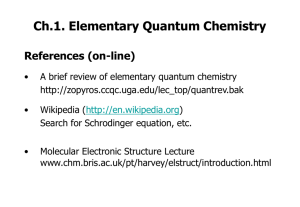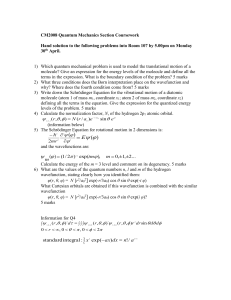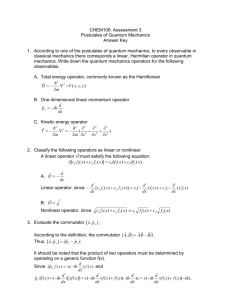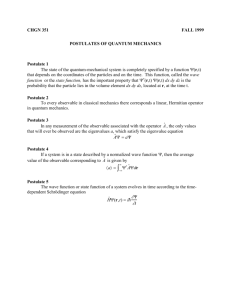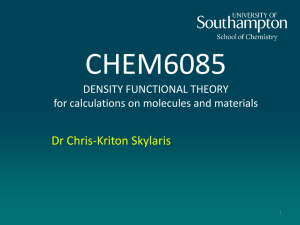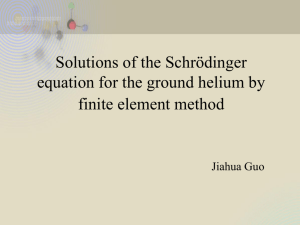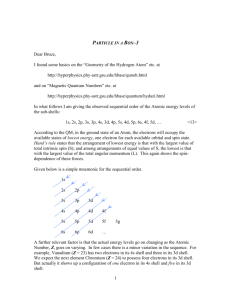슬라이드 1
advertisement
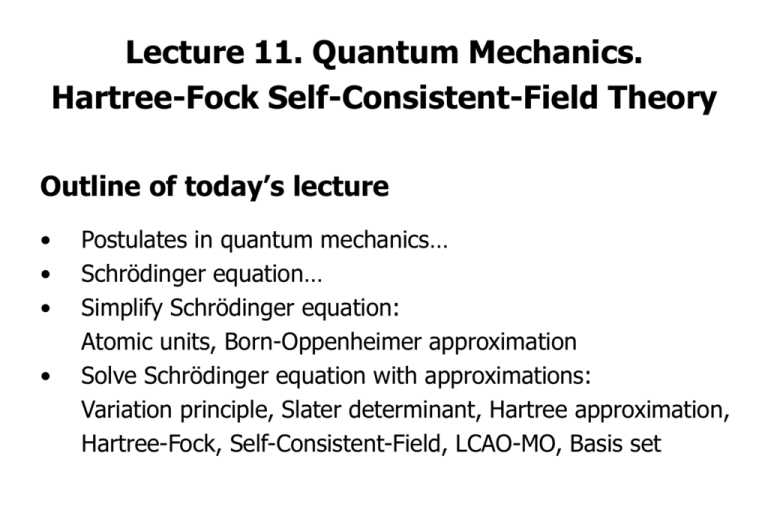
Lecture 11. Quantum Mechanics.
Hartree-Fock Self-Consistent-Field Theory
Outline of today’s lecture
•
•
•
•
Postulates in quantum mechanics…
Schrödinger equation…
Simplify Schrödinger equation:
Atomic units, Born-Oppenheimer approximation
Solve Schrödinger equation with approximations:
Variation principle, Slater determinant, Hartree approximation,
Hartree-Fock, Self-Consistent-Field, LCAO-MO, Basis set
References
• Molecular Quantum Mechanics, Atkins & Friedman (4th ed. 2005), Ch. 1 & 8
• Essentials of Computational Chemistry. Theories and Models, C. J. Cramer,
(2nd Ed. Wiley, 2004) Chapter 4
• Molecular Modeling, A. R. Leach (2nd ed. Prentice Hall, 2001) Chapter 2
• Introduction to Computational Chemistry, F. Jensen (1999) Chapter 3
• A Brief Review of Elementary Quantum Chemistry
http://vergil.chemistry.gatech.edu/notes/quantrev/quantrev.html
• Molecular Electronic Structure Lecture
http://www.chm.bris.ac.uk/pt/harvey/elstruct/introduction.html
• Wikipedia (http://en.wikipedia.org): Search for Schrödinger equation, etc.
Potential Energy Surface & Quantum Mechanics
How do we obtain the potential energy E?
• MM: Evaluate analytic functions (FF)
• QM: Solve Schrödinger equation
3N (or 3N-6 or 3N-5) Dimension PES
for N-atom system
x
Continuum
Modeling
Geometry
rij
Atomistic
Modeling
li
θi
i
Quantum
Modeling
For geometry optimization, evaluate
E, E’ (& E’’) at the input structure X
(x1,y1,z1,…,xi,yi,zi,…,xN,yN,zN) or {li,θi,i}.
Charge
Force Field
Length
0.1 nm
1 nm
1m
1cm
The Schrödinger Equation
The ultimate goal of most quantum chemistry approach is
the solution of the time-independent Schrödinger equation.
(1-dim)
Hamiltonian operator wavefunction
(solving a partial differential equation)
?
Postulate #1 of Quantum Mechanics
• The state of a quantum mechanical system is completely specified by the
wavefunction or state function Ψ (r, t ) that depends on the coordinates of
the particle(s) and on time.
• The probability to find the particle in the volume element d drdt located
at r at time t is given by (r , t ) (r , t )d. (Born interpretation)
• The wavefunction must be single-valued, continuous, finite, and normalized
(the probability of find it somewhere is 1).
d (r , t )
2
1 = <|>
Probability
density
Born Interpretation of the Wavefunction: Probability Density
Probability Density: Examples
B=0
Ae
ikx
A
2
2
A=0
Be
ikx
B
2
2
A=B
2 A cos kx
2
4 A cos 2 kx
nodes
Postulate #2 of Quantum Mechanics
• Once Ψ (r, t ) is known, all properties of the system can be obtained
by applying the corresponding operators to the wavefunction.
• Observed in measurements are only the eigenvalues a which satisfy
the eigenvalue equation
A a
eigenvalue
eigenfunction
(Operator)(function) = (constant number)(the same function)
(Operator corresponding to observable) = (value of observable)
Schrödinger equation: Hamiltonian operator energy
with
(Hamiltonian operator)
(e.g. with
)
Physical Observables & Their Corresponding Operators
with
(Hamiltonian operator)
(e.g. with
)
Observables, Operators & Solving Eigenvalue Equations:
an Example
Aeikx
pˆ x
d
i dx
d
p x
i dx
the same function
d
Aeikx khAeikx kh
i dx
constant
p x kh
number
The Uncertainty Principle
When momentum is known precisely, the position cannot be predicted
precisely, and vice versa.
Ae
ikx
p x kh
A
2
2
When the position is known precisely,
Location becomes
precise at the expense
of uncertainty in
the momentum
Postulate #3 of Quantum Mechanics
• Although measurements must always yield an eigenvalue,
the state does not have to be an eigenstate.
• An arbitrary state can be expanded in the complete set of
eigenvectors (
as
where n .
• We know that the measurement will yield one of the values ai, but
we don't know which one. However,
we do know the probability that eigenvalue ai will occur (
).
• For a system in a state described by a normalized wavefunction ,
the average value of the observable corresponding to
A A d
= <|A|>
is given by
The Schrödinger Equation for Atoms & Molecules
Atomic Units (a.u.)
• Simplifies the Schrödinger equation (drops all the constants)
(energy)
(length)
(mass)
(charge)
1
1
1
1
a.u. =
a.u. =
a.u. =
a.u. =
(before)
1 hartree = 27.211 eV = 627.51 kcal/mol,
1 bohr = 0.52918 Å,
electron rest mass,
elementary charge, etc.
(after)
Born-Oppenheimer Approximation
• Simplifies further the Schrödinger equation (separation of variables)
• Nuclei are much heavier and slower than electrons.
• Electrons can be treated as moving in the field of fixed nuclei.
• A full Schrödinger equation can be separated into two:
– Motion of electron around the nucleus
– Atom as a whole through the space
• Focus on the electronic Schrödinger equation
Born-Oppenheimer Approximation
(before)
(electronic)
(nuclear)
E=
(after)
Electronic Schrödinger Equation in Atomic Unit
Variational Principle
1.
2.
3.
4.
Nuclei positions/charges & number of electrons in the molecule
Set up the Hamiltonian operator
Solve the Schrödinger equation for wavefunction , but how?
Once is known, properties are obtained by applying operators
•
•
No exact solution of the Schrödinger eq for atoms/molecules (>H)
Any guessed trial is an upper bound to the true ground state E.
=
•
=
Minimize the functional E[] by searching through all acceptable
N-electron wavefunctions
Hartree Approximation (1928)
Single-Particle Approach
• Impossible to search through
all acceptable N-electron
wavefunctions.
• Let’s define a suitable subset.
• N-electron wavefunction
is approximated by
a product of N one-electron
wavefunctions. (Hartree product)
Nobel lecture (Walter Kohn; 1998)
Electronic structure of matter
Antisymmetry of Electrons and Pauli’s Exclusion Principle
• Electrons are indistinguishable. Probability doesn’t change.
• Electrons are fermion (spin ½). antisymmetric wavefunction
• No two electrons can occupy the same state (space & spin).
Slater “determinants”
• A determinant changes sign when two rows (or columns) are exchanged.
“antisymmetric”
Exchanging two electrons leads to a change in sign of the wavefunction.
• A determinant with two identical rows (or columns) is equal to zero.
=0
=0
No two electrons can occupy the same state. “Pauli’s exclusion principle”
N-Electron Wavefunction: Slater Determinant
• N-electron wavefunction aprroximated by a product of N one-electron
wavefunctions (hartree product).
• It should be antisymmetrized (
).
Hartree product is not antisymmetric!
Hartree-Fock (HF) Approximation
• Restrict the search for the minimum E[] to a subset of , which
is all antisymmetric products of N spin orbitals (Slater determinant)
• Use the variational principle to find the best Slater determinant
(which yields the lowest energy) by varying spin orbitals
= ij
(orthonormal)
Hartree-Fock (HF) Energy
Hartree-Fock (HF) Energy: Evaluation
Slater determinant
(spin orbital = spatial orbital * spin)
finite “basis set”
Molecular Orbitals as linear combinations of Atomic Orbitals (LCAO-MO)
where
Hartree-Fock (HF) Equation: Evaluation
• No-electron contribution (nucleus-nucleus repulsion: just a constant)
• One-electron operator h (depends only on the coordinates of one electron)
where
• Two-electron contribution (depends on the coordinates of two electrons)
1. Potential energy due to nuclear-nuclear Coulombic repulsion (VNN)
*In some textbooks ESD doesn’t include VNN, which will be added later (Vtot = ESD + VNN).
2. Electronic kinetic energy (Te)
3. Potential energy due to nuclear-electronic Coulombic attraction (VNe)
3. Potential energy due to two-electron interactions (Vee)
• Coulomb integral Jij (local)
> 0, i.e., a destabilization
Coulombic repulsion between electron 1 in orbital i and electron 2 in orbital j
• Exchange integral Kij (non-local) only for electrons of like spins
No immediate classical interpretation; entirely due to antisymmetry of fermions
Hartree-Fock (HF) Energy: Integrals
Self-Interaction
• Coulomb term J when i = j (Coulomb interaction with oneself)
0
• Beautifully cancelled by exchange term K in HF scheme
=0
Constrained Minimization of EHF[SD]
Hartree-Fock (HF) Equation
• Fock operator: “effective” one-electron operator
• two-electron repulsion operator (1/rij) replaced by one-electron operator VHF(i)
by taking it into account in “average” way
and
Two-electron repulsion cannot be separated exactly into one-electron terms. By
imposing the separability, the Molecular Orbital Approximation inevitably involves
an incorrect treatment of the way in which the electrons interact with each other.
Self-Consistent Field (HF-SCF) Method
• Fock operator depends on the solution.
• HF is not a regular eigenvalue problem
that can be solved in a closed form.
1. Start with a guessed set of orbitals;
2. Solve HF equation;
3. Use the resulting new set of orbitals
in the next iteration; and so on;
4. Until the input and output orbitals
differ by less than a preset threshold
(i.e. converged).
Koopman’s Theorem
• As well as the total energy, one also obtains a set of orbital energies.
• Remove an electron from occupied orbital a.
Orbital energy = Approximate ionization energy
Koopman’s Theorem: Examples
Restricted vs Unrestricted HF
Accuracy of Molecular Orbital (MO) Theory
Electron Correlation
• A single Slater determinant never corresponds to the exact wavefunction.
EHF > E0 (the exact ground state energy)
• Correlation energy: a measure of error introduced through the HF scheme
EC = E0 EHF (< 0)
– Dynamical correlation
– Non-dynamical (static) correlation
• Post-Hartree-Fock method
– Møller-Plesset perturbation: MP2, MP4
– Configuration interaction: CISD, QCISD, CCSD, QCISD(T)
Summary
